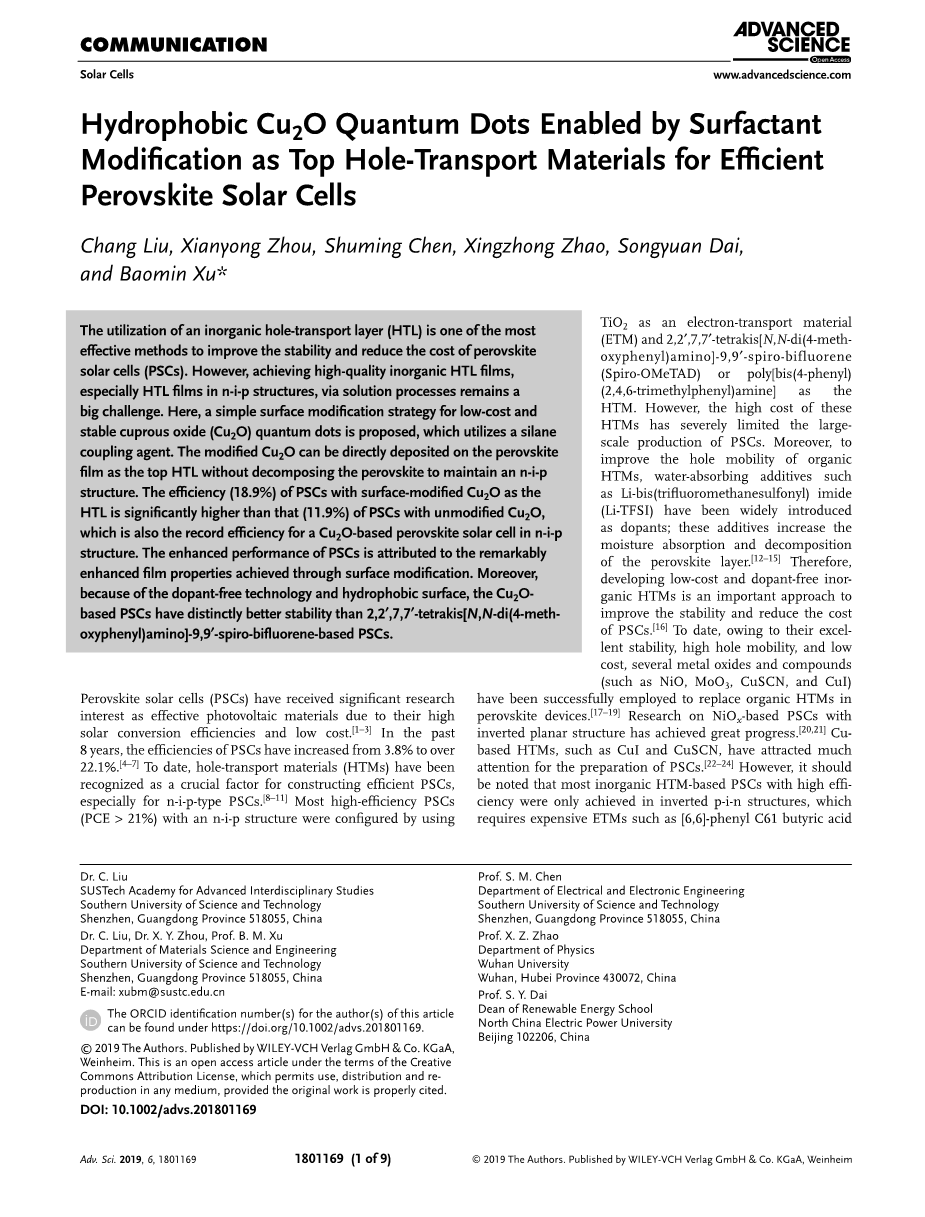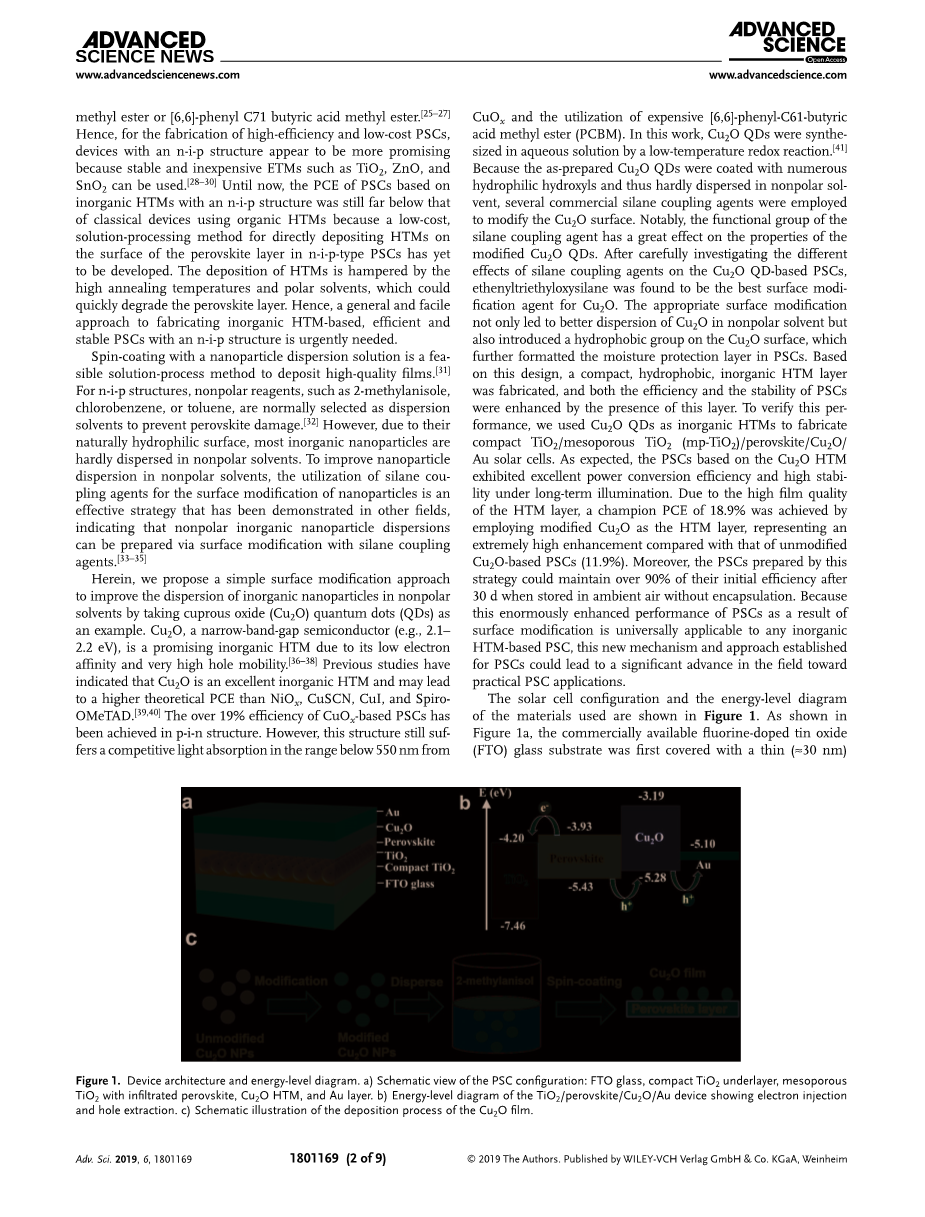表面活性剂改性疏水性Cu2O量子点作为高效钙钛矿太阳能电池顶部空穴传输材料外文翻译资料
2022-08-07 10:39:18


英语原文共 9 页,剩余内容已隐藏,支付完成后下载完整资料
Hydrophobic Cu2O Quantum Dots Enabled by Surfactant Modification as Top Hole-Transport Materials for Efficient Perovskite Solar Cells
Chang Liu, Xianyong Zhou, Shuming Chen, Xingzhong Zhao, Songyuan Dai, and Baomin Xu*
Abstract
The utilization of an inorganic hole-transport layer (HTL) is one of the most effective methods to improve the stability and reduce the cost of perovskite solar cells (PSCs). However, achieving high-quality inorganic HTL films, especially HTL films in n-i-p structures, via solution processes remains a big challenge. Here, a simple surface modification strategy for low-cost and stable cuprous oxide (Cu2O) quantum dots is proposed, which utilizes a silane coupling agent. The modified Cu2O can be directly deposited on the perovskite film as the top HTL without decomposing the perovskite to maintain an n-i-p structure. The efficiency (18.9%) of PSCs with surface modified Cu2O as the HTL is significantly higher than that (11.9%) of PSCs with unmodified Cu2O, which is also the record efficiency for a Cu2O-based perovskite solar cell in n-i-p structure. The enhanced performance of PSCs is attributed to the remarkably enhanced film properties achieved through surface modification. Moreover, because of the dopant-free technology and hydrophobic surface, the Cu2O-based PSCs have distinctly better stability than 2,2rsquo;,7,7rsquo;-tetrakis[N,N-di(4-methoxyphenyl)amino]-9,9rsquo;-spiro-bifluorene-based PSCs.
Perovskite solar cells (PSCs) have received significant research interest as effective photovoltaic materials due to their high solar conversion efficiencies and low cost.[1–3] In the past 8 years, the efficiencies of PSCs have increased from 3.8% to over 22.1%.[4–7] To date, hole-transport materials (HTMs) have been recognized as a crucial factor for constructing efficient PSCs, especially for n-i-p-type PSCs.[8–11] Most high-efficiency PSCs (PCE gt;21%) with an n-i-p structure were configured by using TiO2 as an electron-transport material (ETM) and 2,2rsquo;,7,7rsquo;-tetrakis[N,N-di(4-methoxyphenyl)amino]-9,9rsquo;-spiro-bifluorene (Spiro-OMeTAD) or poly[bis(4-phenyl) (2,4,6-trimethylphenyl)amine] as the HTM. However, the high cost of these HTMs has severely limited the large-scale production of PSCs. Moreover, to improve the hole mobility of organic HTMs, water-absorbing additives such as Li-bis(trifluoromethanesulfonyl) imide (Li-TFSI) have been widely introduced as dopants; these additives increase the moisture absorption and decomposition of the perovskite layer.[12–15] Therefore, developing low-cost and dopant-free inorganic HTMs is an important approach to improve the stability and reduce the cost of PSCs.[16] To date, owing to their excellent stability, high hole mobility, and low cost, several metal oxides and compounds (such as NiO, MoO3, CuSCN, and CuI) have been successfully employed to replace organic HTMs in perovskite devices.[17–19] Research on NiOx-based PSCs with inverted planar structure has achieved great progress.[20,21] Cu- based HTMs, such as CuI and CuSCN, have attracted much attention for the preparation of PSCs.[22–24] However, it should be noted that most inorganic HTM-based PSCs with high efficiency were only achieved in inverted p-i-n structures, which requires expensive ETMs such as [6,6]-phenyl C61 butyric acid methyl ester or [6,6]-phenyl C71 butyric acid methyl ester.[25–27] Hence, for the fabrication of high-efficiency and low-cost PSCs, devices with an n-i-p structure appear to be more promising because stable and inexpensive ETMs such as TiO2, ZnO, and SnO2 can be used.[28–30] Until now, the PCE of PSCs based on inorganic HTMs with an n-i-p structure was still far below that of classical devices using organic HTMs because a low-cost, solution-processing method for directly depositing HTMs on the surface of the perovskite layer in n-i-p-type PSCs has yet to be developed. The deposition of HTMs is hampered by the high annealing temperatures and polar solvents, which could quickly degrade the perovskite layer. Hence, a general and facile approach to fabricating inorganic HTM-based, efficient and stable PSCs with an n-i-p structure is urgently needed.
Spin-coating with a nanoparticle dispersion solution is a feasible solution-process method to deposit high-quality films.[31] For n-i-p structures, nonpolar reagents, such as 2-methylanisole, chlorobenzene, or toluene, are normally selected as dispersion solvents to prevent perovskite damage.[32] However, due to their naturally hydrophilic surface, most inorganic nanoparticles are hardly dispersed in nonpolar solvents. To improve nanoparticle dispersion in nonpolar solvents, the utilization of silane coupling agents for the surface modification of nanoparticles is an effective strategy that has been demonstrated in other fields, indicating that nonpolar inorganic nanoparticle dispersions can be prepared via surface modification wit
剩余内容已隐藏,支付完成后下载完整资料
资料编号:[246519],资料为PDF文档或Word文档,PDF文档可免费转换为Word
您可能感兴趣的文章
- 元素对Ti-xAl-yMo-zV和Ti-xAl-yMo-zCr β-Ti合金应变速 率敏感性的影响外文翻译资料
- 复合工艺提高先进钠离子电池的电位窗口外文翻译资料
- 氧化还原催化辅助下的高稳定钒氧化还原流电池外文翻译资料
- 用于高压可伸缩储能的电解锌锰电池外文翻译资料
- 表面活性剂改性疏水性Cu2O量子点作为高效钙钛矿太阳能电池顶部空穴传输材料外文翻译资料
- Nb 和 Ni 共掺杂 Mg(0001)氢解离扩散的理论研究:外文翻译资料
- 低温固相法制备锂离子电池正极材料LiFeSO4F毕业论文
- 锂空气电池新型正极催化剂Gd2Zr2O7的制备与性能研究毕业论文
- 酸类添加剂对beta”-Al2O3电泳沉积成型法的影响毕业论文
- CuZr非晶合金中短程有序结构及其与玻璃形成能力的关系研究毕业论文




